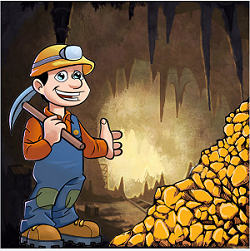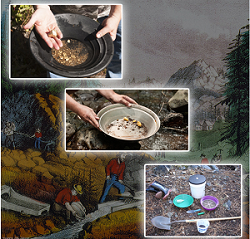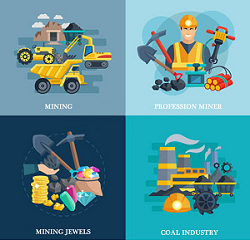INTERESTING FACTS ABOUT MINING:
?Mining is important to our economy, but mostly people don?t realize how vital and integrated the mining industry is in our everyday lives! Not all of us are aware of a lot of facts related to mining and resources which are quite interesting to know and to let know. Some of the following facts are quite obvious while the rest are something which we surely are unaware of.
One of the simplest types of mining is gold panning. Gold is heavier than river sand and sinks to the bottom if you rinse it with water.
Gold and copper were the first metals to be discovered by man around 5,000 BC.
Petroleum is used to make over 6,000 items which includes dresses, paint, CD players, antifreeze, lipstick and hair coloring products.
Most modern electronic devices contain over 35 minerals all together.
The chemical symbol for gold which is derived from the Latin word- Aurum actually means shining dawn.
Archaeologists have discovered copper drain pipes from as far back as 3,500 BC that are still in good condition.
In Pre-Columbian times, indigenous people in North America mined turquoise, jet, opal, copper, silver, coal, obsidian and other igneous rocks, asbestos, salt, and sodium sulfate, as well as other minerals.
Turquoise, jet, opal, copper, and silver were mined mostly for decorative use. Coal was mined for fuel. Obsidian and other igneous rocks were mined to make projectile points, mortars and pestles, grinding stones, stone axes, and other tools. Clay and asbestos were mined for pottery, salt was used as a preservative and for flavoring in foods and sodium sulfate was used as a purgative.
The Luck of the Irish is an old mining expression from the gold and silver rush in the second half of the 19th century.
A micro coating of gold on glass reflects solar energy and reduces the electrical demand of air conditioning.
Fool?s Gold can be one of three minerals-the most common mineral which is always mistaken for gold is pyrite, chalcopyrite ?also appears gold-like and weathered biotite mica can mimic flake gold which again appears to be like gold.
69 days is known to be the longest time till date to be survived underground after the occurrence of a mining disaster.
Until 1886, aluminum was considered a rare metal and a chemical curiosity. Researchers in the U.S. and France independently discovered the continuous electrolytic reduction process which is used to make aluminum metal from bauxite, an aluminum ore.
Twenty-Four-carat Gold is not pure gold since there is a small amount of copper in it. Absolutely pure gold is so soft that it can be molded with the hands.
After gold has been mined, approx. 63 per cent of it is used in jewelry, 21 per cent as coins, 15 per cent for industrial uses including electronics and the other 1 per cent in dental.
Gold will not oxidize, rust, tarnish, corrode, decay, or deteriorate.
Zinc is 100 per cent recyclable and over 80% of zinc available for recycling is recycled.
Copper does not corrode, rust or damage easily.
The Cullinan diamond is the largest gem quality diamond ever found which weighs around 3106.75 carat.
US is known to be the world?s largest producer of clay, gypsum, lithium, magnesium, phosphate, salt, silicon and sulfur.
Canada is one of the largest mining nations in the world, producing more than 60 minerals and metals.
Shaft mining is very dangerous. Men dig a mine shaft vertically into the earth until they meet a seam?a place rich in mineral deposits. The miners then dig horizontal shafts to dig out the minerals in the seam. These shafts get very hot and it?s hard to breathe. Rocks fall and sometimes gas explodes. The deepest shaft mine is the TauTona gold mine in South Africa which is 2.4 miles deep.
Open pit mines are simply big, open holes with terraced sides. Coal, copper and other minerals are dug out of the pits. Very deep pits sometimes hold uranium. Once the minerals or coal is gone, the pits are filled with trash and covered with soil. The biggest open pit mine in the world is the Bingham Canyon copper mine in Utah, which is almost one mile deep.
Quarrying is the process of cutting stone, usually out of a mountainside. Years ago, quarrymen used dynamite or hammers and wedges to split the rock off the mountain. Today, mechanized saws do the work.
Oil rigs drill for oil far out in the ocean. Underneath the rocks lie ?the oil and gas reserves.
Every American uses an average of 40,000 pounds of new minerals each year.
A newborn baby will need 800 pounds of lead, 750 pounds of zinc, 1500 pounds of aluminum, 32,700 pounds of iron, 26,550 pounds of clay, 28,213 pounds of salt, 1,238,101 pounds of stone, sand, gravel and cement during its lifetime.
?Because of wood shortages in the 1600?s, Brewers in England started drying their Malts with heat generated by coal. Unfortunately, coal flavored beer was not a hit. After more experiments, the brewers found that the undesirable gases could be eliminated by heating the coal in an air tight oven. Thus the discovery of the coke making process that has been an essential part in the making of iron and steel.
Slag found on islands in the Aegean Sea suggests that man was separating silver from lead as early as 3000 B.C.!
In ancient times, an ounce of salt was traded for an ounce of gold!
Silver is the best conductor out of all the elements and thus the reason why it is used so heavily in technology.
Silver is also a superior anti-bacterial. Small concentrations kill bacteria by chemically breaking down their cell membranes since bacteria cannot develop a resistance to silver!
Zinc is the fourth most widely consumed metal after iron, aluminum and copper and is also vital to the human body for proper function and health. Zinc is needed for the body?s enzymes and immune system.
Indium is a byproduct of zinc production and is also used in high technology applications from LCD screens to solar panels.
Wyoming is the nation?s top coal-producing state.
In ancient times salt was traded for an ounce for gold. Salt was once made into 'coins' and 'cakes' in china and also used as a currency in the Mediterranean regions. Several cultures levied taxes on salt.
Gold was first legalized as money as early as 1091 BC in China as an alternative to silk. Gold is still the only universally accepted medium of exchange.
Gold is the most ductile (easily molded or shaped) of all metals, allowing it to be drawn out into tiny wires or threads without breaking. As a result, a single ounce of gold can be drawn into a wire five miles long. Gold's malleability is also unparalleled. It can be shaped or extended into extraordinarily thin sheets. For example, one ounce of gold can be hammered into a 100 square foot sheet.
The greatest gold rush in U.S. History began when gold was discovered at Sutter's mill in California by a man named James Marshall on January 24th, 1848.
The Pikes Peak gold rush in 1859 opened up Colorado and launched the city of Denver.
Homestake mine, in Lead, South Dakota, is one of the largest gold mines in the US Operations began on April 9, 1876 and is the oldest continually operating gold mine in the world.
?2000 years ago the Chinese used an alloy of nickel. Pure nickel was first isolated in 1751 by Axel Cronstedt, a Swedish scientist.
The Soviet Union is the world?s top nickel producer weighing in at about a one fourth of the world?s total in nickel production.
Nitric acid was one of the first acids known. Many alchemists of the Middle Ages used it in their experiments.
Salts are taken from the ground and purified and end up on your kitchen table. Deposits were formed by the evaporation of large parts of oceans millions of years ago. In these natural formations, also occur calcium carbonate and potash. Underground salt deposits are found all around the world.













